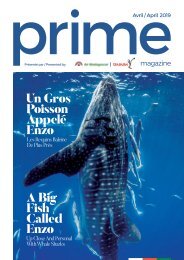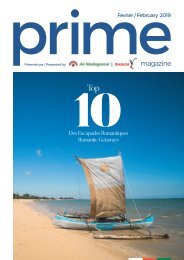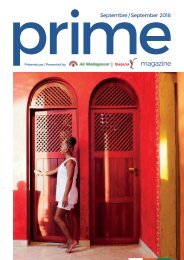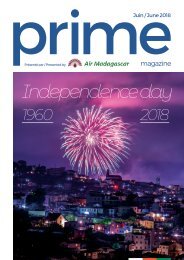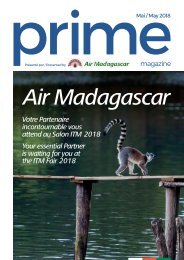PRIME MAG - AIR MAD - MARCH 2019 - SINGLE PAGES - LO-RES
Create successful ePaper yourself
Turn your PDF publications into a flip-book with our unique Google optimized e-Paper software.
FEATU<strong>RES</strong><br />
C'est un défi de collecter des données à Madagascar ?<br />
Si vous regardez une carte de l'île, vous verrez<br />
qu’il existe de grandes étendues qui ne sont pas<br />
accessibles par le réseau routier principal. Par<br />
conséquent, nous devons faire face à de nombreux<br />
défis logistiques pour amener les équipes, la<br />
nourriture, une montagne de matériel de recherche<br />
et tout le reste sur les sites situés dans des zones<br />
reculées.<br />
Au fil des années, nous avons utilisé une grande<br />
variété de moyens de transport, comme des bateaux<br />
ou des chars à bœuf, mais les plus souvent ce<br />
sont des porteurs locaux que nous avons engagés<br />
pour nous accompagner à pied sur des distances<br />
considérables et nous permettre d’atteindre des<br />
forêts de l'île jusqu'alors inconnues.<br />
How challenging is it to collect data in<br />
Madagascar?<br />
If you look at a map of the island, vast areas are not<br />
accessible by the principal road network. Hence, for<br />
remote zones there are numerous logistic challenges<br />
to get the team and a mountain of research material,<br />
food, and other gear into sites.<br />
Over the years we have used a variety of<br />
different means including boats and oxen carts,<br />
but principally engaging local porters and walking<br />
considerable distances to reach some of the<br />
previously unknown forests of the island.<br />
Votre dernier ouvrage phare sur les zones protégées<br />
de Madagascar sort ce mois-ci. C'est une bonne<br />
lecture pour un vol long courrier ?<br />
Oui, ce livre a été conçu, au moins en parti, pour<br />
inciter les touristes à visiter Madagascar, afin<br />
qu’il puissent découvrir différents aspects de<br />
l’écosystème des zones protégées.<br />
En 1989, Martin Nicoll et Olivier Langrand ont<br />
publié un livre sur ce qui était alors connu des<br />
zones protégées de l'île. Au fil des décennies, il s'est<br />
passé beaucoup de choses en ce qui concerne<br />
l'augmentation du nombre de zones protégées<br />
de l'île, les surfaces couvertes, et beaucoup de<br />
recherches ont été effectuées sur les organismes<br />
qui vivent sur ces sites.<br />
C'est quelque chose de remarquable et de très<br />
positif. Par exemple, il y a aujourd'hui 338 espèces<br />
de vertébrés connus dans la zone protégée de<br />
Marojejy qui se trouve dans le Nord-Est entre<br />
Sambava et Andapa, alors qu'il n'y en avait que 164<br />
en 1989.<br />
Remarque<br />
L'ouvrage bilingue anglais-français intitulé "Les aires protégées terrestres de<br />
Madagascar : Leur histoire, description et biote" (The terrestrial protected areas of<br />
Madagascar: Their history, description, and biota) édité par Steve Goodman, Marie<br />
Jeanne Raherilalao et Sébastian Wohlhauser, est disponible à Antananarivo, auprès<br />
de l'association Vahatra, près d'Ankatso. Le livre est au prix de 200$, soit 175€, ou<br />
l’équivalent en ariary malgache. Pour plus d'informations sur l'achat de cet ouvrage,<br />
ainsi que sur d’autres ouvrages publiés par l'association Vahatra sur la biodiversité<br />
malgache, appelez le 22-27755 (depuis Madagascar), et pour trouver le chemin<br />
pour vous rendre à l'association : http://www.vahatra.mg/planfr.html. Le livre est<br />
également disponible auprès de la Presse de l'Université de Chicago (https://www.<br />
press.uchicago.edu/ucp/books/publisher/pu3431914_3431915.html).<br />
Photo : Zombitse<br />
Dans ce nouveau livre, qui fait plus de 1700<br />
pages et qui a presque 1000 images en couleur,<br />
différents aspects sont examinées, comme<br />
24 différents sujets sur chacune des 98 zones<br />
protégées, et, pour chaque site, un tableau complet<br />
de tous les vertébrés connus. Nous espérons que le<br />
livre aidera à relancer l'écotourisme dans l'île.<br />
Your latest seminal book on the protected areas of<br />
Madagascar is published this month. Good read for<br />
a long haul flight?<br />
Yes, the book is intended, at least in part, to help<br />
visitors to Madagascar to discover aspects of its<br />
protected area system.<br />
In 1989, Martin Nicoll and Olivier Langrand<br />
published a book describing what was known at<br />
that time about the island’s protected area. Over the<br />
following three decades a lot has happened regarding<br />
the augmentation of the number of protected areas<br />
on the island, and the covered surface area, and a<br />
vast amount of research on the organisms that live at<br />
these sites.<br />
This aspect is remarkable and very positive. For<br />
example, today 338 species of vertebrates are known<br />
from the Marojejy protected area found in the northeast<br />
between Sambava and Andapa, as compared to<br />
164 in 1989.<br />
In this new book, which is over 1700 pages, and<br />
with close to 1000 colour images, we examine many<br />
aspects, including 24 different subjects for each of the<br />
98 protected areas covered with, for each site, a table<br />
of the known vertebrates. It is our hope that the book<br />
will help relaunch ecotourism on the island.<br />
Footnote:<br />
The bilingual French-English book entitled “Les aires protégées terrestres<br />
de Madagascar : Leur histoire, description et biote / The terrestrial<br />
protected areas of Madagascar: Their history, description, and biota” edited<br />
by Steve Goodman, Marie Jeanne Raherilalao, and Sébastian Wohlhauser, is<br />
available in Antananarivo at Association Vahatra, near Ankatso. The price of<br />
the book is $200, 175 Euros or the equivalent in Malagasy ariary. For further<br />
information on obtaining the book as well as other Association Vahatra<br />
titles on Malagasy biodiversity, call 22-27755 (in Madagascar) and to find a<br />
map to the office see http://www.vahatra.mg/planfr.html. The book is also<br />
available from The University of Chicago Press (https://www.press.uchicago.<br />
edu/ucp/books/publisher/pu3431914_3431915.html).<br />
Magazine online<br />
www.primemedia.international<br />
| 15 |



